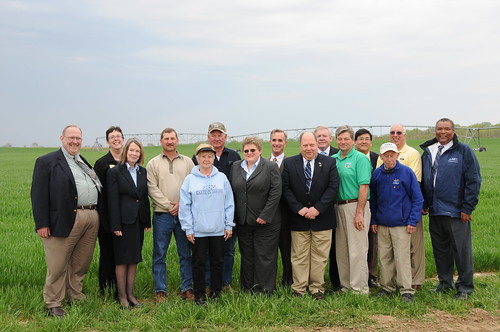
A few scattered showers didn’t dampen spirits at a Maryland Earth Day event to highlight the completion of the improved Worton Wastewater Treatment Plant, Tuesday April 19.
“This is a great example of a public-private partnership working to help restore and protect the Chesapeake Bay and its tributaries,” Deputy Under Secretary for Rural Development Cheryl Cook said. “USDA is especially proud of its efforts to help fund upgrades and improvements to local wastewater disposal systems which directly impact the Bay.”
The ceremony took place at Piccadilly Farm located about 2 miles from Worton’s Wastewater Treatment Plant (WWTP) that is owned and operated by Kent County Commissioners. The $11.5 million upgrades to the WWTP were funded by USDA Rural Development and the Maryland Department of the Environment. The “state of the art” system is in compliance with more stringent regulations to eliminate the discharge of treated effluent into Morgan Creek, located near the Middle Chester River. The treated effluent will be put into use on agriculture fields at Piccadilly Farm owned by the Dill family. The spray irrigation site at Piccadilly Farm, includes a holding pond, pump station, and five center-pivot irrigation units that can apply treated wastewater over 75 acres of farmland.
Maryland Department of Agriculture official Buddy Hance said, “In the State of Maryland there are 1,800 acres of farmland with spray irrigation to apply treated wastewater. This is an example of agriculture stepping up to provide a solution for small communities.”
It was no surprise to the Kent County Commissioners that Frankie Dill and his family would step up to the plate to help their local community. The farm includes 183 tillable acres mostly planted with corn, wheat and soybeans. For the Dill’s it was a perfect opportunity to enhance their crops and help the environment too.
The farm is also enrolled in USDA’s Conservation Reserve Enhancement Program (CRE) which is supported by USDA’s Farm Service Agency and Natural Resources Conservation Service, the Maryland Department of Agriculture, and the Kent Soil and Water Conservation District. Approximately 19 acres are in CREP buffers, waterways, ponds and grade stabilization which protect water quality and decrease erosion and runoff.
All of these efforts are helping to protect and restore, our National Treasure, the Chesapeake Bay!




